


Review: Benelli M2 20 Gauge Comfortech Autoloader

The Benelli M2 is described as the “workhorse” of the Benelli line, a term not exactly riddled with hyperbole. The 20 gauge field guns are offered in black or RealTree APG camo, with 24 or 26 inch barrels. Like most all Benelli autoloaders, the M2 has a hard-chrome lined barrel that is cryogenically treated. Having been very favorably impressed with the handling and balance of the Benelli 12 gauge Ultra-Light with its 24 inch barrel, I opted for the 24 inch route in this M2 as well.
The M2 has a stated approximate weight of 5.7 pounds. Well, time to grab the Lyman digital trigger gauge and do some weighing and weight comparisons. The M2 as tested weighs in at 6 pounds on the nose. A Beretta 303 with a fixed choke 28 inch barrel and hard plastic buttplate weighs 6-1/4 pounds, as does a 26 inch Invector choked Browning B-80 with factory rubber butt, while a Belgian A-5 20 Mag with a 26 inch plain barrel is 6 pounds, nine ounces. Of recently reviewed 20 gauge repeaters, both a Browning Silver and a Beretta Urika 2 Gold weighed in at 6 pounds 5 ounces, while an 870 Wingmaster 20 gauge 28 inch hit 6 pounds, 14 ounces and a Browning 20 gauge BPS tipped the scales at 7-1/2 pounds. The Remington “Sporting 20” 1100 pushed the scales at whopperdoodle 8 pounds.
The length of pull as Benelli states is 14-3/8 inches on the M2, with an 1-1/2 in. DAC and a 2-1/4 inch DAH. These dimensions are approximate as they can be changed with the included shim kit and the addition of optional recoil pads of different thicknesses. The 24 inch barrel might sound short to some, but isn't what you might think due to the longish receiver of the M2. The nominal overall length of the tested M2 is 45.3 inches, actually a bit longer (and lighter) than a 2010 model 28 inch barreled Browning Cynergy Field O/U being tested concurrently.
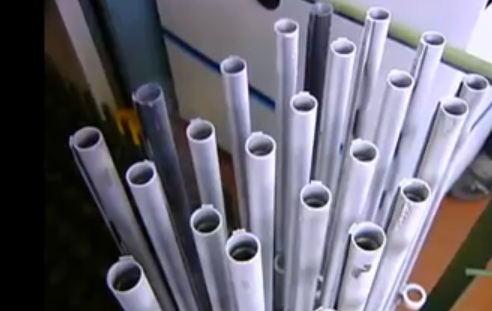
The mystery of the strange and wondrous Cryo barrels continues. I can't say exactly what some of the other miracles may or may not be. I can say that the M2 Cryo barrel with its hard-chrome lining stays remarkably clean while shooting and is quick and easy to clean when it finally needs it.
The point of all this weighing is not that it is my hobby or even particularly enjoyable. It illuminates the wide disparity of shotgun weights in general and in 20 gauge in particular. Some twenty gauges weigh more than 3-1/2 inch chambered waterfowl guns, so gauge alone is representative of nothing specifically. The Benelli M2 20 gauge is the lightest twenty gauge repeating shotgun I've tested in a decade. It is lighter than most pumps and O/U's as well, and lighter than many 28 gauges.
The checkering pattern on Benelli's Comfortech stock is dubbed “AirTouch,” the same as used on most Comfortech stocks except for the Vinci. I really like it; it really gives you good control of your shotgun and is far superior to some of the greasy-feeling, rubberized type polymer stock configurations out there. The M2 is both supremely well-balanced and blazingly fast to the shoulder. It comes with shims for stock adjustment, but the M2 fit me perfectly right out of the box so no shim-changing was required.
The M2 has an obnoxious silver center bead on the rib that is just straight retarded. Like the fat fellow that when he gets his shoes shined, he has to take the guy's word for it, the same is true of the front bead on the M2. The center bead obliterates the view of the front bead, so whether it is there or not in actual shooting is anyone's guess. Center beads on field shotguns make no sense; a center bead that blocks out the front bead makes even less sense. Benelli isn't the only shotgun manufacturer that is guilty of this type of lunacy. I've picked on Remington for foisting a center bead on a recently reviewed 870 that rendered the front bead completely invisible and useless, so it is only fair to carp a bit whenever such a dunderheaded practice is employed, regardless of manufacturer. There is no easy way to unscrew the center bead, apparently a pin vise is an “iffy” proposition, so attempting to twist it off with pliers broke it off flush with the rib to my immense delight. Problem solved. Oddly enough, Benelli has the same item #11087 listed on their website as a “Turkey Gun with Comfortech.” It appears to be the same identical gun only without the center bead. If I was smart, which I obviously am not, I would have gone for the turkey gun and skipped the nasty bead drama.
The trigger-guard safety of the M2 is ideally placed and easy to get off. All too often we forget how vitally important an intuitive safety is, until we get the pleasure of watching a cackling rooster fly off into the distance. Benelli has done a superb job here. A light, extremely responsive field gun is all well and good, but if you if can't effortless get your safety off throwing rocks at pheasants might work at least as good as your shotgun.
The sole problem remaining with the supplied M2 is the trigger that breaks at a heavier weight than the entire gun at 6-1/2 pounds. Good triggers on shotguns seem to be rare commodities these days. However, after talking with the good folks at Benelli I'm advised that most M2 triggers run in the 3-5 pound area. So, just as soon as I'm finished with this review the trigger guard is going off to Benelli and I'll report back with the results. Benelli has had extremely good customer service in times past, so there is no reason to think that this instance will be any different.
Out at the range, the M2 performed flawlessly without a single hiccup. It digested Winchester promo loads, 1 oz. AA's, 1-1/4 oz. three inch shells, and the Federal 1-5/16 oz. loads I used for patterning without a hitch. It was completely reliable right-out of the box, regardless of what it was fed.
All of the shooting was done with a thin shirt on, no hunting coat or shooting vest. The M2 was surprisingly soft to shoot. Far, far more comfortable than some heavier O/U models, and actually noticeably softer shooting than a heavier Beretta Urika 2 Gold 20 gas gun with its vinyl crucifix buttplate. It is dramatically softer shooting with 1 oz. AA loads than a substantially heavier Citori 28 gauge with 3/4 oz. loads. Most 28 gauges don't kick much but apparently this Citori didn't read that part. Also noticeable was the absence of muzzle flip with the 1 oz. AA's. I expected some with this light of a gun and a short barrel, but it just wasn't there.
I also ran through a box of 1-1/4 oz. 3 inch #5 shot loads. They moved me around a bit, to be sure, but were still surprisingly comfortable. Around here, if you go through two boxes of pheasant loads in a season, you've had a fabulous season. The M2 20 gauge is ideally suited for that. With hunting gear on combined with a wild pheasant hitting the sky you won't feel anything.
The bore of the Benelli M2 as measured by Skeets bore gauge is .620 in. The Improved Modified tube used for patterning had a surprising light constriction of .022 in. Shooting off bag and cradle at the bench, with Federal 1-5/16 oz. 3 inch loads was the only time recoil was uncomfortable, without the benefit of the entire body to absorb it. Off the bench again reinforced how heavy the supplied trigger really was-- it felt like I was pulling on it forever. The Benelli M2 gave beautifully centered patterns at 40 yards, very even with no patchiness about two inches high, an ideal field pattern for flushing game. It shot to point of aim. This is a very good thing, as many shotguns do not.
I appreciate highly polished blue and hand-checkered walnut as much as anyone. Along with that comes the knowledge that a blued barrel is a pre-rusted barrel that requires some care. There's red oxide, the stuff we generally don't like, and black oxide that sounds better if we call it bluing. Bluing is fine for many applications, but for the all-weather hunter it has its downside as well. The same goes with walnut stocks. Wood can absorb oil and soften, can of course crack, and checkering may quickly wear down with use. Wood stocks do nothing to manage recoil. It is easy to appreciate the craftsmanship of beautifully inletted walnut, the hand-rubbed oil finishes, and the eye-catching grain.

The M2 forearm is slimmer and trimmer than possible with systems that must allow for gas arrays and action bars, with only the magazine tube that needs to be housed. The AirTouch checker pattern is functional, with durability that fine-line wood checkering cannot equal.
There is also room for appreciation of the art and craftsmanship involved in costly, multi-cavity molds and other tooling where design engineers must take into consideration shrink rates, stress areas, and consistency of the end product. If you are a tool-maker, a mold-maker, or a materials design engineer you are no less an artisan and a craftsman than the wood-worker or engraver. In the case of this M2, the engineered result is weight, balance, corrosion-resistance, and shooting comfort not possible with the use of traditional, organic materials. I can certainly appreciate the advances it offers the active hunter and the M2 Comfortech is as good as an example as any of this.
Stripping down the M2 couldn't be much easier, a child of six could do it. Unfortunately, six year old children are rarely handy when you really need them, so you'll find it easy to do yourself. Unscrew the forearm cap, pull off the charging handle, knock out a drift pin and the rest is close to self-explanatory. That's one of the benefits when you don't have action bars or springs in the barrel nut to fuss with.
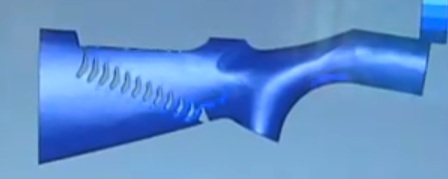
This Benelli-generated model of the Comfortech stock shows where the recoil-absorbing flex points are. It just plain works.
There is little doubt left in my once young mind about how well the Comfortech stock works. All anyone has to do is pull the trigger versus any shotgun in the same weight bracket including Benelli's own Weathercoat-stocked Ultralight 12 gauge with similar loads and you'll instantly find the difference to be night and day. It isn't the softest-shooting 20 gauge ever, for physics puts a limit on that sooner or later. For the record, the softest-shooting 20 gauge in my experience with target loads is the original Browning Gold 20 gauge, no longer in production, which tips the scales at 7-1/4 pounds. Though soft-shooting, it is decidedly a ponderous pig compared to the M2 Comfortech.
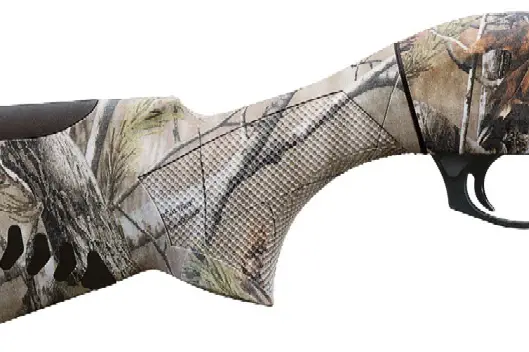
The strength and functionality of the M2's Comfortech stock cannot be matched with traditional, organic materials. The image above also shows the well-designed and positioned safety that is intuitively effortless to get off.
For an upland hunting gun, the M2 is hard to beat. With target loads, you can shoot it all day. More important for pheasant aficionados, you'll actually be delighted to carry it all day as well. Fast and responsive is a great advantage for grouse and quail hunting, and the M2 fits the bill there as well. Now that Federal Heavyweight #7 20 gauge loads have proven to be devastatingly effective on turkey, the M2 is just ideal to handle in the close quarters of a turkey blind. A momentary poke of a camo barrel out of a blind beats highly polished blue every time.
This review will be updated with progress on the trigger and with patterning examples from more loads, including Federal Heavyweight turkey loads. For now, I can tell you that the Benelli M2 Comfortech is the lightest, fastest-shouldering, best handling, most hassle-free repeating 20 gauge I've tested in recent memory. It is a fabulous, astonishingly good field gun.
5/21/2010 Update: The trigger was evaluated and adjusted by Benelli Customer Service, improving the original break weight of 6-1/2 lbs. to 4-3/4 lbs. as measured by Lyman Electronic trigger gauge, a substantial and welcomed change. As mentioned above, stripping the M2 is pathetically easy. Take off the barrel and forearm, pull off the bolt handle and slide out the bolt assembly, tap out one pin from the receiver and out comes the trigger group. That's all there is to it. Internally, it was so clean you couldn't tell that it had ever been fired. A light coat of Montana Extreme Gun oil on the breech assembly was all the lube it received prior to reassembly.
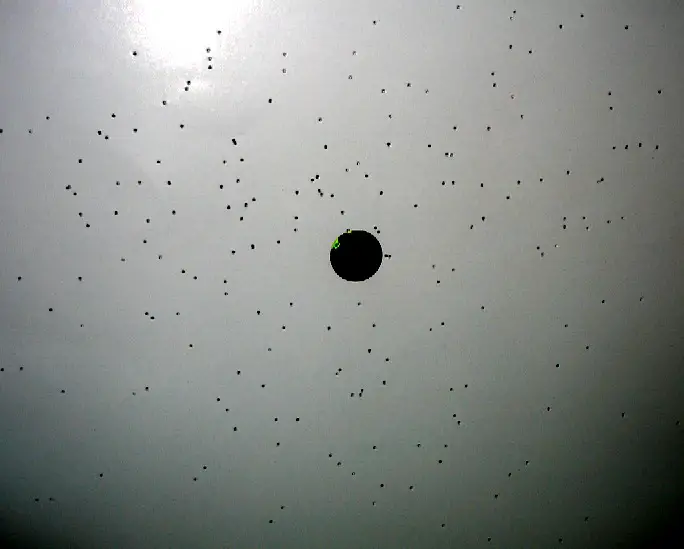
At a laser-verified 42 yards, the best patterns were with Federal Heavyweight #7 loads in combination with a Trulock Precision Hunter " Turkey" Extended choke tube. This specific Trulock choke, #PHCRP20580, has an exit diameter of .580 inches yielding a constriction in this barrel of .040 in.: not particularly aggressive for a turkey choke, but with more than adequate results to take any gobbler to 45 yards. Above is the "entrance" side of the pattern, with a 1-1/4 inch bull to give you scale. Below, the exit side of the same pattern displays the very even yet dense dispersion of this combination.
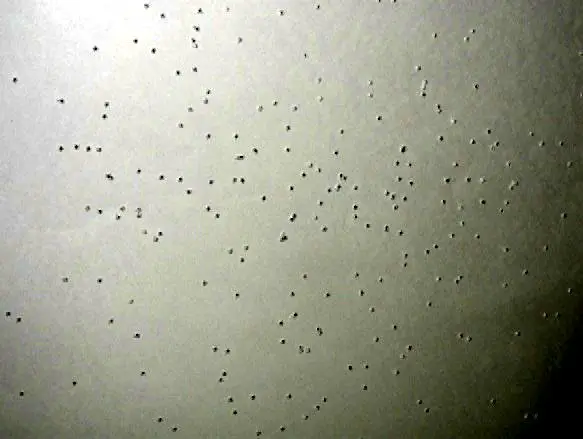
Though some might think that "Full" or "Extra Full" would not be the first choice to hunt with, that's why we pattern. Likely due to the light constriction afforded by the M2's tight barrel, we found that all the factory Benelli chokes threw unacceptably thin patterns at 42 yards to be good, reliable dove-droppers or pheasant poppers at longer distances, with the Trulock PH "Full" the only choke tube considered usable at that range.
As a result, it seems that a Trulock PH "Extra Full" (effective constriction of .030 in.) is going to be the choke tube of choice for dove and pheasant. The factory tubes are light on constriction and neither the Benelli "IM" or "Full" tubes are rated for steel or the harder no-tox shot types, where all Trulock Precision Hunter tubes are.
Some of this pattern-testing helps explain the mythology that a solid choke throws better patterns than a screw choke. The recently tested (but brand new condition) Browning A-5 20 Mag threw beautiful 40 yard patterns with its factory full choke. Now, for the rest of the story. The A-5 20 Mag factory full barrel has a tighter constriction than even the Trulock "Extra Full" Precision Hunter. Benelli is generous, supplying five choke tubes, but none of them equal a Trulock "Full" or "Extra Full" in performance or constriction.
One can hardly expect a factory "Improved Cylinder" choke to perform as marked when it has only four thousandths of one inch of constriction, with the "CYL" tube actually an overbore of .007 in. They don't. But again, that's why we have to pattern our shotguns.
What IS refreshingly good about the
Benelli M2 is that it shoots dead-on to point of aim at 42 yards. Shooting
to point of aim is something that is becoming increasingly rare in factory
shotguns, so it is always a somewhat unexpected pleasure to pattern a
shotgun that throws a pattern where it is supposed to.
Copyright 2010 by Randy Wakeman. All Rights Reserved.

Custom Search



